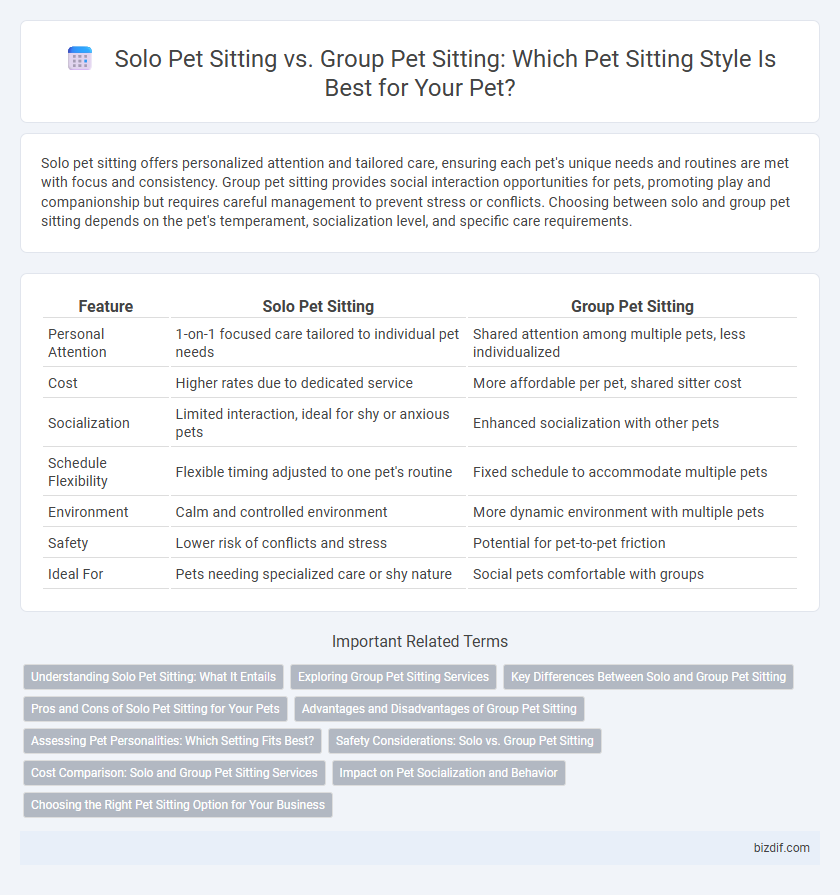Solo pet sitting offers personalized attention and tailored care, ensuring each pet's unique needs and routines are met with focus and consistency. Group pet sitting provides social interaction opportunities for pets, promoting play and companionship but requires careful management to prevent stress or conflicts. Choosing between solo and group pet sitting depends on the pet's temperament, socialization level, and specific care requirements.
Table of Comparison
| Feature | Solo Pet Sitting | Group Pet Sitting |
|---|---|---|
| Personal Attention | 1-on-1 focused care tailored to individual pet needs | Shared attention among multiple pets, less individualized |
| Cost | Higher rates due to dedicated service | More affordable per pet, shared sitter cost |
| Socialization | Limited interaction, ideal for shy or anxious pets | Enhanced socialization with other pets |
| Schedule Flexibility | Flexible timing adjusted to one pet's routine | Fixed schedule to accommodate multiple pets |
| Environment | Calm and controlled environment | More dynamic environment with multiple pets |
| Safety | Lower risk of conflicts and stress | Potential for pet-to-pet friction |
| Ideal For | Pets needing specialized care or shy nature | Social pets comfortable with groups |
Understanding Solo Pet Sitting: What It Entails
Solo pet sitting involves personalized, one-on-one care where the sitter focuses entirely on a single pet's needs, behavior, and routine, ensuring tailored attention and minimal distractions. This approach allows for close monitoring of health, feeding, exercise, and emotional support, ideal for pets requiring special care or with anxiety issues. Solo pet sitting reduces the risk of inter-pet conflicts and promotes a calm, controlled environment that supports the pet's well-being.
Exploring Group Pet Sitting Services
Group pet sitting services offer socialization opportunities that solo pet sitting cannot provide, allowing pets to interact and play with others under professional supervision. This environment helps reduce loneliness and promotes mental stimulation, benefiting dogs and cats alike. Choosing group pet sitting can be more cost-effective while ensuring attentive care tailored to multiple pets' needs simultaneously.
Key Differences Between Solo and Group Pet Sitting
Solo pet sitting offers personalized one-on-one care tailored to an individual pet's specific needs and routines, ensuring focused attention and reduced stress for shy or anxious animals. Group pet sitting involves caring for multiple pets simultaneously, providing socialization opportunities but potentially less individualized supervision, which is ideal for pets comfortable in social settings. Key differences include the level of personalized interaction, supervision intensity, and the social environment's impact on pet behavior and well-being.
Pros and Cons of Solo Pet Sitting for Your Pets
Solo pet sitting offers personalized, one-on-one attention, ensuring your pet's unique needs and behaviors are closely monitored and catered to during each visit. However, it may limit social interaction opportunities that group settings provide, potentially affecting pets that thrive on social engagement with other animals. The focused environment of solo pet sitting can reduce stress and anxiety for pets sensitive to noise and activity but may require more commitment and availability from the pet sitter.
Advantages and Disadvantages of Group Pet Sitting
Group pet sitting offers socialization opportunities for pets, reducing loneliness and promoting natural behavior through interaction with other animals. It can be more cost-effective for owners, but may lead to increased stress or conflict among pets with different temperaments or socialization levels. The sitter must manage group dynamics carefully to ensure safety and individual attention for each pet.
Assessing Pet Personalities: Which Setting Fits Best?
Assessing pet personalities is crucial in determining whether solo pet sitting or group pet sitting is the best fit. Pets with anxiety or special needs often benefit from solo pet sitting, where individualized attention helps reduce stress and behavioral issues. Conversely, social and well-adjusted pets typically thrive in group pet sitting environments that provide interaction and mental stimulation.
Safety Considerations: Solo vs. Group Pet Sitting
Solo pet sitting offers individualized attention, reducing the risk of injury from interactions between multiple animals and allowing closer monitoring of each pet's behavior and health. Group pet sitting, while more social for pets accustomed to company, requires careful management to prevent conflicts and ensure that all animals receive adequate supervision to avoid accidents. Safety protocols in group settings include secure enclosures and staff trained in animal behavior to effectively handle emergencies and minimize stress-induced incidents.
Cost Comparison: Solo and Group Pet Sitting Services
Solo pet sitting services typically charge higher rates due to personalized, one-on-one attention and customized care plans, averaging $25 to $40 per visit. Group pet sitting benefits from economies of scale, reducing costs to around $15 to $25 per pet, as multiple animals are cared for simultaneously. Choosing between solo and group pet sitting depends on budget considerations and the specific needs of pets requiring individual care or social interaction.
Impact on Pet Socialization and Behavior
Solo pet sitting provides individualized attention, reducing stress and anxiety for pets with social or behavioral challenges, promoting calm and balanced behavior. Group pet sitting encourages socialization opportunities that help pets develop interpersonal skills and reduce loneliness, beneficial for well-adjusted and social animals. Choosing between solo and group care depends on the pet's temperament and socialization needs to optimize behavioral outcomes.
Choosing the Right Pet Sitting Option for Your Business
Solo pet sitting offers personalized, one-on-one care, ideal for clients seeking dedicated attention and customized services for their pets. Group pet sitting allows for multiple animals to be cared for simultaneously, optimizing time and resources but requiring strong organizational skills to manage diverse pet needs safely. Selecting the right pet sitting option depends on business capacity, client preferences, and the ability to maintain high-quality care standards while maximizing efficiency.
Solo pet sitting vs Group pet sitting Infographic

 bizdif.com
bizdif.com